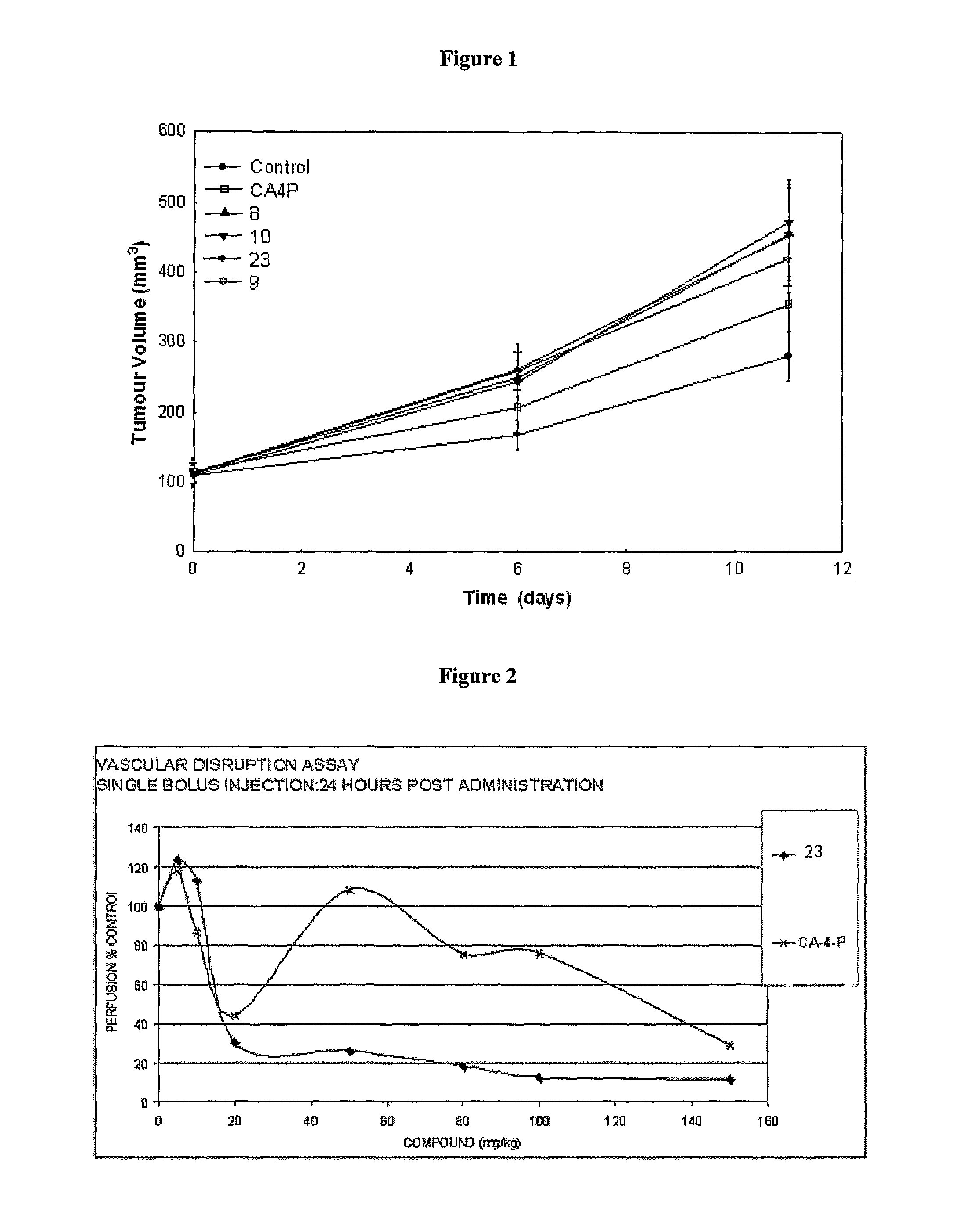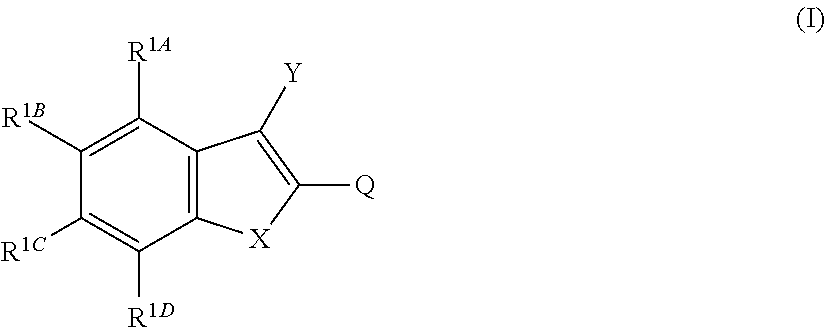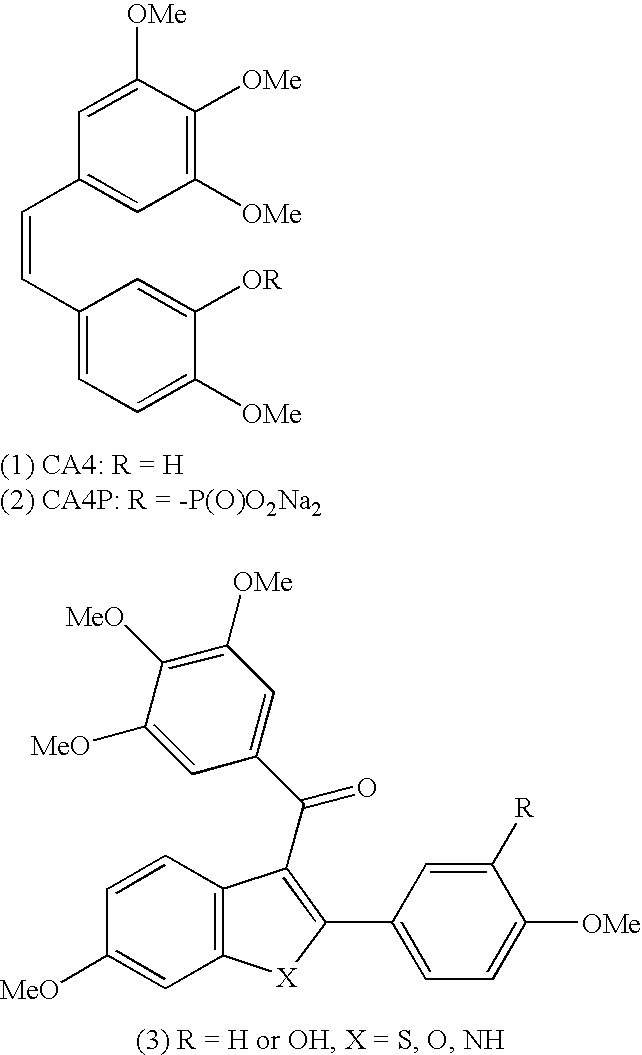Tubulin polymerisation inhibitors
a technology of tubulin and polymerization inhibitors, which is applied in the field of chemical compounds, can solve the problems of tissue damage, cell death by an apoptosis mechanism, and change in endothelial cell morphology,
- Summary
- Abstract
- Description
- Claims
- Application Information
AI Technical Summary
Benefits of technology
Problems solved by technology
Method used
Image
Examples
example 1
[0224]A series of compounds of the invention were prepared by carbonylative multicomponent coupling (see Scheme 1).
[0225]General Procedure for Carbonylative Multicomponent Coupling
[0226]To a solution of iodophenol (1 eq) and alkyne (1.2 eq) in dry THF (5 mL / mmol) under nitrogen at 0° C. was added methyl magnesium chloride (solution in THF, 2.5 eq) and the reaction allowed to warm to room temperature. After stirring for 10 minutes, Pd(Ph3P)2Cl2 (5 mol %) was added and the reaction heated to 65° C. for 4-8 h (tic). The THF was removed under vacuum and replaced with DMSO (12 mL / mmol) and the nitrogen atmosphere was replaced with carbon monoxide. The aryl iodide (1.05 eq) was added and the reaction heated to 90-100° C. overnight then quenched with 10% NH4Cl(aq) and extracted with ethyl acetate. The organic layer was washed with brine and the solvent removed under vacuum. The residue was concentrated onto silica gel and purified by flash column chromatography.
a) Preparation of 6-Methoxy-...
example 2
[0256]A series of compounds of the invention were prepared by derivatization of the 1-pyrazolyl position of [6-Methoxy-2-(1H-pyrazol-4-yl)-benzofuran-3-yl]-(3,4,5-trimethoxyphenyl)-methanone
a) Preparation of {4-[6-Methoxy-3-(3,4,5-trimethoxy-benzoyl)-benzofuran-2-yl]-pyrazol-1-yl}-acetic acid ethyl ester (Entry 30, Table 1)
[0257]
[0258]To a stirred solution of [6-Methoxy-2-(1H-pyrazol-4-yl)-benzofuran-3-yl]-(3,4,5-trimethoxyphenyl)-methanone (45 mg, 0.091 mmol) and potassium carbonate (40 mg, 0.29 mmol) in dry DMF (2.5 mL) was added ethyl bromoacetate (30 μL, 0.27 mmol) and the reaction heated to 70° C. for 2 h. After cooling to room temperature the reaction mixture was quenched with 10% NH4Cl(aq) (20 mL) and extracted with ethyl acetate (30 mL). The organic layer was separated and washed with water (3×10 mL) and brine (10 mL), dried over magnesium sulphate and the solvent removed under reduced pressure. The crude residue was purified by flash column chromatography (silica gel, eluen...
example 3
[0271]Derivitisation of the 1-imidazoyl position of [2-(1H-Imidazol-4-yl)-6-methoxy-benzofuran-3-yl]-(3,4,5-trimethoxyphenyl)-methanone
a) Preparation of [2-(1-methyl-1H-Imidazol-4-yl)-6-methoxy-benzofuran-3-yl]-(3,4,5-trimethoxyphenyl)-methanone (Entry 39, Table 1)
[0272]
[0273]This material was prepared by N-methylation of [2-(1H-Imidazol-4-yl)-6-methoxy-benzofuran-3-yl]-(3,4,5-trimethoxyphenyl)-methanone (entry 45, Table 1) was made from Il-0085 by N-methylation. 20 mg of starting material (0.049 mmol) was dissolved in 1 ml dry THF then treated with 9 mg of 60% NaH (0.225 mmol) then after 10 minutes with MeI (15 uL, 0.24 mmol) and left over night then quenched with 10% NH4Cl extracted with EtOAc and chromatographed with straight EtOAc to give 12 mg product (58% yield). Proton data is 7.86 (s, 1H), 7.62 (s, 1H), 7.13-7.09 (m, 2H), 7.12 (s, 2H), 6.79 (dd, J=8.7, 2.1 Hz, 1H), 3.92 (s, 3H), 3.84 (s, 3H), 3.76 (s, 6H), 3.72 (s, 3H).
PUM
| Property | Measurement | Unit |
|---|---|---|
| temperature | aaaaa | aaaaa |
| time | aaaaa | aaaaa |
| temperature | aaaaa | aaaaa |
Abstract
Description
Claims
Application Information
 Login to View More
Login to View More - R&D
- Intellectual Property
- Life Sciences
- Materials
- Tech Scout
- Unparalleled Data Quality
- Higher Quality Content
- 60% Fewer Hallucinations
Browse by: Latest US Patents, China's latest patents, Technical Efficacy Thesaurus, Application Domain, Technology Topic, Popular Technical Reports.
© 2025 PatSnap. All rights reserved.Legal|Privacy policy|Modern Slavery Act Transparency Statement|Sitemap|About US| Contact US: help@patsnap.com



